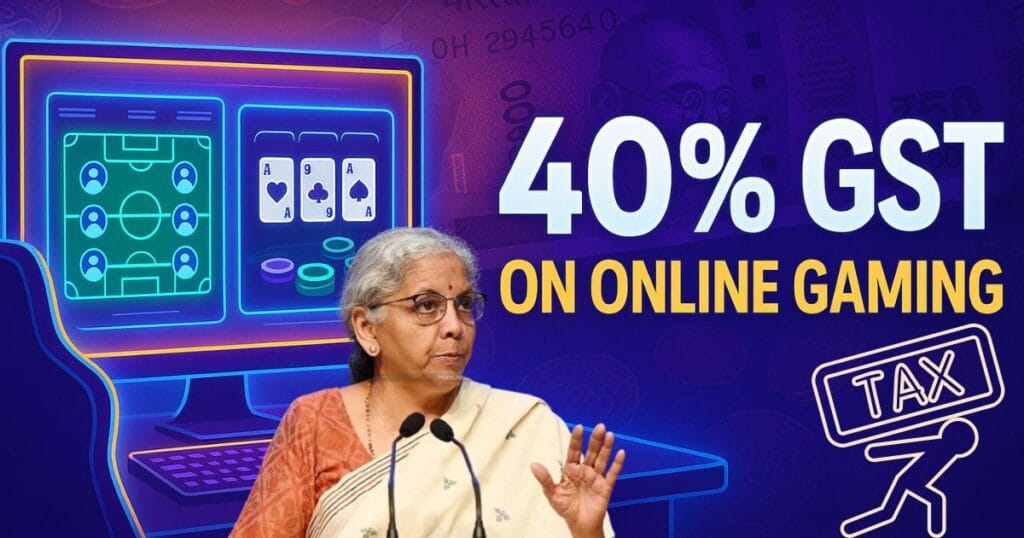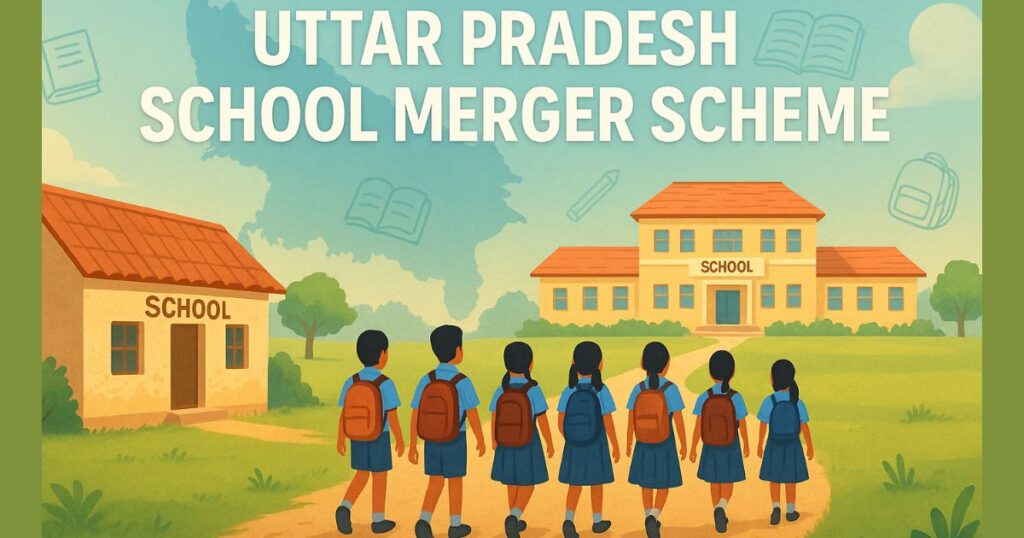The online gaming industry in India is growing rapidly, but a new government proposal has stirred up a storm. The central government is planning to increase the GST on online gaming, particularly real-money games like fantasy sports, from the current 28% to 40%. This change could significantly impact gaming companies and players, potentially reshaping the entire industry. In this article, we’ll explain the proposal, covering its effects, benefits, risks, and all related aspects.

What is the Proposal and Why is it Important?
The Indian government is preparing to raise the GST on online gaming from 28% to 40%. This move aims to achieve two main goals:
- Increase revenue: A higher tax will bring in more money for the government, which can be used for public welfare schemes.
- Stricter regulation: By classifying online gaming as a “sin good” (like gambling or alcohol), the government wants to control it more tightly.
Currently, people spend around ₹10,000 crore monthly on online gaming. With such a massive market, a 40% GST could generate significant revenue for the government. However, this will increase pressure on gaming companies, and players will need to comply with stricter KYC (Know Your Customer) and AML (Anti-Money Laundering) rules. This proposal is a game-changer for the gaming industry and its millions of users.
Timeline of the Proposal
- The proposal will first go to the Group of Ministers (GoM) for review.
- Then, the Fitment Committee will examine it.
- Finally, the GST Council will make a decision by October 2025.
- Keep an eye on the 56th GST Council meeting scheduled for August 2025.
Market Size: How Big is the Gaming Industry?
According to Chief Economic Advisor V. Anantha Nageswaran, in July 2025, Indians spent approximately ₹10,000 crore on online gaming. This translates to an annual market size of about ₹1.2 lakh crore. With such a large market, a 40% GST could bring in substantial revenue. Here are some key figures:
| Details | Value |
|---|---|
| July 2025 Spending | ₹10,000 crore |
| Annual Estimated Spending | ₹1.2 lakh crore |
| Current GST Rate | 28% |
| Proposed GST Rate | 40% |
These numbers highlight how massive the online gaming industry is and why it’s a key revenue source for the government.
Why Does the Government Want to Increase GST?
The government has several reasons for this proposal:
- Discouraging gambling: By treating real-money games as “sin goods,” the government aims to reduce gambling-like activities.
- Boosting revenue: A higher GST will provide funds for schemes like education, healthcare, and employment.
- Tighter regulations: Stricter KYC and AML rules will help prevent fraud and illegal money transactions.
However, gaming companies and experts are opposing this move. They argue that such a high tax rate could harm the industry, stifle innovation, and push players toward illegal platforms. This creates a challenge to balance government goals with industry growth.
KYC and AML Rules: What Will Change?
KYC means players must verify their identity (e.g., with Aadhaar or PAN) before joining a Online Gaming platform. AML rules require platforms to monitor for illegal money transactions. These rules will:
- Prevent fraud and money laundering.
- Enhance player safety.
- Make the gaming industry more transparent.
However, these rules on Online Gaming might make it harder to start playing, as identity verification takes time. There’s also a concern about data privacy, as players may worry about their personal information being leaked. Still, these regulations will make the industry more trustworthy.
Impact on Gaming Companies
The 40% GST and stricter rules will put significant pressure on Online Gaming companies:
- Small companies at risk: Higher taxes and compliance costs could be too much for small and medium-sized firms, potentially forcing them out of the market.
- Job losses: Companies may cut staff to reduce costs.
- Reduced investment: Lower profits could discourage investors from funding the industry.
- Higher in-game costs: Items like skins or bonuses may become more expensive, as companies pass on the tax burden.
This could slow down the gaming industry’s rapid growth, affecting startups and innovation in India.
Impact on Players
The 40% GST will make online gaming more expensive, especially for low-income players. Key impacts include:
- Costlier gaming: Higher costs may reduce how much people play.
- Risk of illegal platforms: Players might turn to cheaper, unregulated foreign platforms, increasing risks of fraud and data theft.
- Social inequality: Low-income players may lose access to gaming as a form of entertainment, widening inequality.
Benefits for the Government
The proposal offers several advantages for the government:
- Increased revenue: A 40% GST will generate significant funds for welfare schemes like MNREGA, education, and healthcare.
- Gambling control: Higher taxes and stricter rules will curb gambling and addiction.
- Transparency: KYC and AML rules will make the industry more accountable.
Risks and Unintended Consequences
However, there are potential risks:
- Rise of illegal platforms: Expensive gaming could push players to unregulated platforms, reducing government revenue.
- Innovation slowdown: High taxes may discourage new ideas and investments.
- Disputes: Conflicts between central and state governments over tax sharing could arise.
What Do Experts Say?
Experts believe the 40% GST is too high and could harm the industry. They argue:
- It will reduce jobs, weaken startups, and discourage investment.
- Players may shift to illegal platforms, hurting government revenue.
- A slab-based or value-based tax system could be a better alternative.
Experts suggest balancing player safety with their right to entertainment.
Lessons from Other Countries
Different countries have unique approaches to online gaming:
- United Kingdom: Taxes are based on company profits, with strict player protection rules.
- Singapore: Strict regulations and varying tax rates apply after licensing.
- United States: Some states impose individual-level taxes.
India could learn from these models and adopt a balanced tax system that supports innovation, investment, and player safety.
What’s Next?
- The proposal will go to the Group of Ministers (GoM) for review.
- The Fitment Committee will analyze it.
- The GST Council will finalize the decision by October 2025.
- Watch for updates from the 56th GST Council meeting in August 2025.
If 40% GST is Implemented, What Should You Do?
5 Tips for Gaming Companies:
- Automate tax compliance systems for accurate and timely payments.
- Use digital tools for KYC and AML compliance.
- Be transparent with players about tax hikes and their impact.
- Leverage technology to reduce operational costs.
- Advocate for balanced policies with the government.
5 Tips for Players:
- Explore free-to-play games or affordable platforms.
- Set a gaming budget and stick to it.
- Choose only legal and secure platforms.
- Report any suspected fraud to authorities.
- Stay informed about new tax and regulatory updates.
Government’s Diwali Gift: GST Reform Brings Relief to Common People and Businesses
When will the 40% GST be implemented?
If approved, it could take effect by October 2025. The proposal awaits approval from the Group of Ministers, Fitment Committee, and GST Council.
Will this tax apply to all games?
The 40% GST mainly targets real-money games like fantasy sports. Free-to-play or skill-based games may face less or no impact.
Will skill-based games also face 40% GST?
It’s unclear, but the focus is on real-money games. Skill-based games currently face 28% GST, and if money is involved, they might also fall under the new tax rate.
Conclusion
The 40% GST proposal on online gaming could transform the industry in India. It may generate significant revenue for the government but will challenge gaming companies and players. Stricter regulations will improve transparency but could slow innovation. Players may need to adopt new strategies to manage costs. Stay updated on GST Council meetings for the latest developments.
If you found this article helpful, share it with others and leave your thoughts in the comments!


